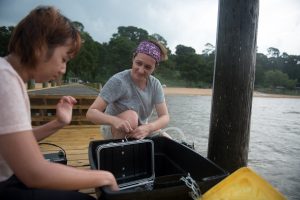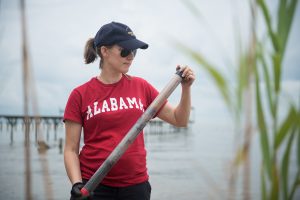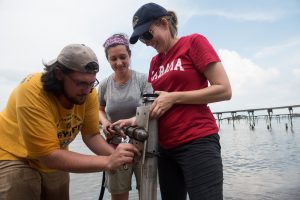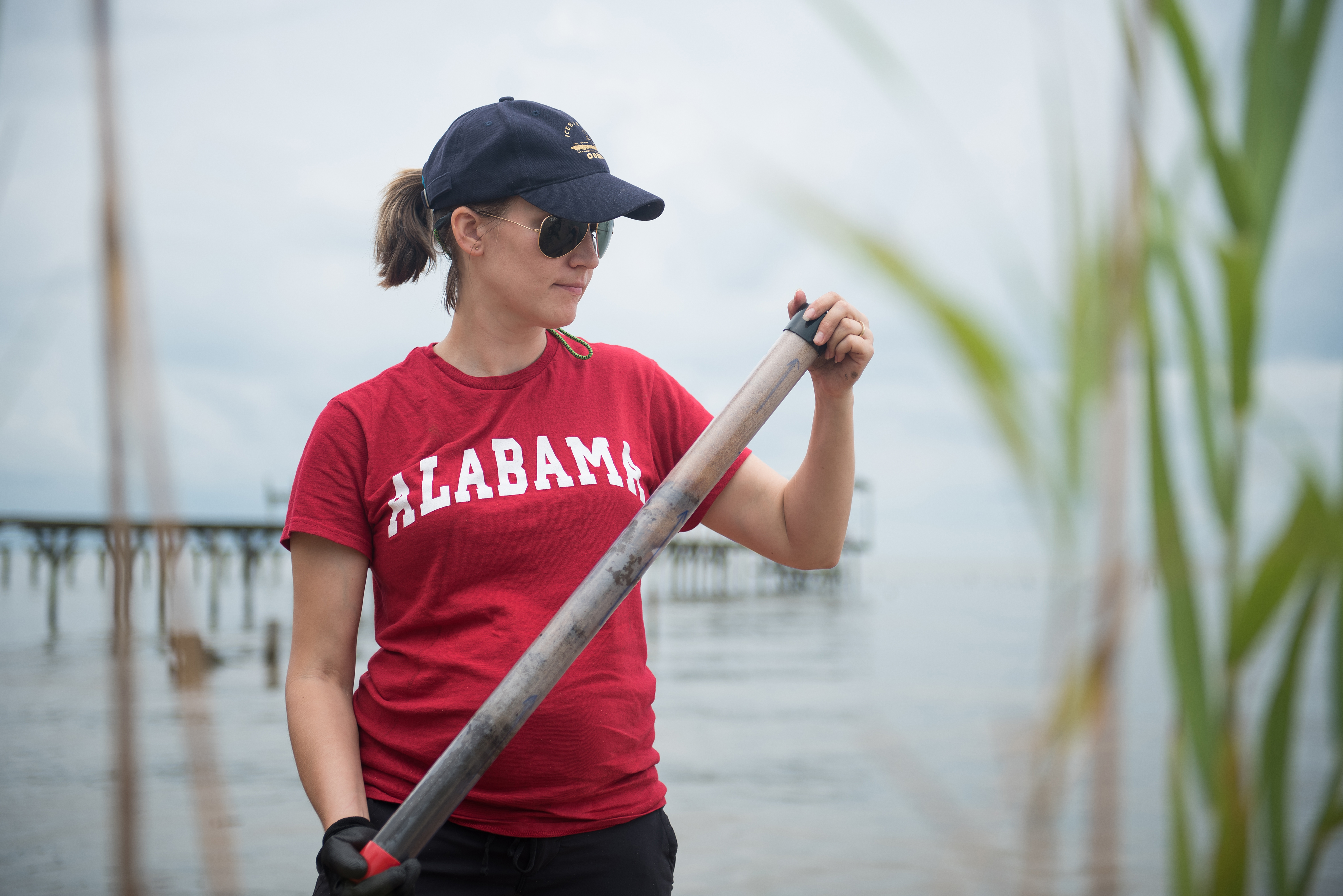UA researchers set out to understand the role of groundwater in Mobile Bay
By Adam Jones | Photos by Zach Riggins
FAIRHOPE, Ala. — It must have been an odd sight from the shore. A small boat puttering along the eastern shore of Mobile Bay barely moving, except to sway with the waves.
No fishing poles. No crab traps. No swimsuits and sunbathing.
Just three students from The University of Alabama dutifully operating an array of scientific instruments lining the deck of the boat. Methodically surveying the bay, looking for water within water, on a deliberate path with a steady speed.
“We explore the shoreline of Mobile Bay for groundwater discharge,” said doctoral student Daniel Montiel, the person in charge of the expedition that day.
Montiel is part of a team of researchers from the University studying the effects of submarine groundwater discharge, or the flow of water underground into the sea, on the water quality of the bay. It is a transformative project to help plan and manage for a number of challenges including rising sea levels, mercury advisories and harmful algal blooms.
“The broad picture is all about maintaining water resources in Alabama,” said Dr. Natasha Dimova, assistant professor and a marine and environmental geochemist in UA’s geological sciences department and Montiel’s advisor.
Major Player

Mobile Bay is the fourth largest estuary in the United States with 413 square miles, fed by the second largest delta in the country, the Mobile–Tensaw River Delta. Water flows out of the bay at 62,000 cubic feet of water per second. Hugged by rivers and the Gulf of Mexico, it is difficult to imagine groundwater as a major player in the bay’s ecology.
But, simply put, it is. Accounting for a trickle of water, 2.5 percent, in the bay compared to water from the Mobile River, groundwater punches above its weight class during the dry season, delivering half of the nitrogen derived from ammonium into the bay, according to studies by Dimova. Nitrogen is critical for the health of the estuary, but too much of it brings problems that can affect water quality and economic activity, such as the lively seafood industry.
“Although everybody assumes that the river is the major player in terms of nutrient fluxes, we found very recently that groundwater plays an important role during certain times of the year, and thus cannot be neglected,” Dimova said.
Common sense reveals this, too. Since groundwater takes longer to reach the ocean than a river, groundwater has the time to accumulate more chemicals, nutrients and heavy metals.
Dimova’s work studying submarine groundwater discharge around the Mobile Bay and Delta point to the possibility of something else boosting groundwater’s potency just before it leaks into the bay – coastal sediments.
“All the data falls in this corner tells us the quality of the groundwater coming out is largely determined by what happens in the coastal sediments just before the discharge,” she said.
This is the first time Dimova’s group considered the sediments as a source of contaminants. Previous studies assumed groundwater was a vector, picking up from farther on land and dropping it in the ocean, Dimova said.
It is not that simple.
“What we sample immediately at the point of discharge in the bay has a very different composition than what is on land,” she said. “Our data shows very clearly that’s what really happens.”
Gauging Impact

A motivation to study submarine groundwater discharge in Mobile Bay is a unique phenomenon called jubilees, moments when huge numbers of marine life such as fish and crabs swarm shallow waters. Sometimes they can result in a massive fish kill.
One of the important triggers of jubilees are an increase in algae, or small marine plants, in what are named harmful algal blooms. These blooms occur when an abundance of nutrients that algae feed off release into the bay. They can have severe economic impact on the seafood industry and tourism that thrive in and around the bay.
While rivers bring spikes of nutrients from human and animal waste, along with agriculture and industrial run-off, into the bay when heavy rains usher them downstream, there are also harmful algal blooms in the dry season. Why? Groundwater, according to Dimova.
Her team’s work clearly shows hot spots of submarine groundwater discharge coincide with frequently observed areas of jubilees in Mobile Bay during the dry season. This distribution in and around the bay is confirmed by the amount of nitrogen, specifically ammonium, present. This points to groundwater delivering half of the nitrogen during the same time of the year.
How her team finds this information goes back to Montiel and the other students trolling the bay. Unlike measuring for nutrient fluxes from rivers, where gauges are plopped into the flowing river, getting information from water underground is more difficult.
The instruments on the boat look for a signature element, an isotope of radon, abundant in groundwater. Hot spots of the element mean more groundwater in the bay. The team joins the data with other measurements of water quality taken from the boat, piecing together location and time of the collection to create a picture of what is in the water and its source.
That information combines with samples of groundwater taken from holes the team digs along the shore to give an idea of what is in the water just before it passes through sediment and what is in the water inside the bay.
“The rivers have been studied, so we are adding the component of groundwater,” Dimova said.
Core Knowledge

When sorting out the influence of groundwater on the health of the bay and influence on harmful algal blooms, Dimova wants to know what is in the sediment. Below the surface, the sediment can tell the history of the bay, shedding light on when there have been harmful algal blooms.
Initial work shows the sediments are storehouses for nutrients in an organic layer that Dimova’s team discovered around Mobile Bay just below the surface. It’s seen when a rod, or core, of sediment is carved out and pulled from the soil. The sediment also holds onto toxic metals such as mercury, which, when consumed by fish, hurts the seafood industry.
“Even though we might not have active contamination right now, the sediments have been contaminated for years and years with heavy metals and nutrients and now they become an independent source of contamination,” she said.
If coastal sediment is a source of contamination, it could have consequences on water quality for the future if sea levels continue to rise, Dimova said.
“Imagine that sediment that has never been touched by sea water, and now that sea water is going up. It’s going to shake everything,” she said. “It’s a ticking bomb to me.”
Along with the nutrients affecting the bay today and potentially affecting it in the future, the sediment tells an intricate history of sea level and environmental changes in the bay. That is where Dr. Rebecca Totten Minzoni, also UA assistant professor of geological sciences, comes in.
Sediment cores provide a longer timeline to help understand how and when increased contributions of nutrients occurred. Minzoni can reconstruct long-term climatic and environmental changes since Mobile Bay formed roughly 8,200 years ago.
Not only can this long perspective show information about storm impacts, floods and ecological responses to these events before instrumental records began or humans settled the area, but sediment cores help researchers learn how the coast responded to past rates of sea level rise.
That is important to communities around the bay, considering the Gulf of Mexico is rising at a rate not seen since the period when the bay formed, according to Minzoni.
“With the cores we collect in Mobile Bay, we can step back in time with each layer to tell us about how environments changed, and ultimately produce a long-term frequency of the harmful algal blooms over time,” Minzoni said.

While nutrients themselves do not preserve well in the sediment record, silica walls of microscopic, single-celled organisms, called diatoms, which are a large part of harmful algal blooms, are left behind, preserved for millions of years.
These microscopic fossils in the sediment mark occurrences of past algal blooms in Mobile Bay. The presence in a core of course sediment sourced from rivers can help determine whether the ancient blooms were triggered by nutrients from rivers or from other sources such as groundwater.
That can show whether the blooms and jubilees seen since European settlement, and the subsequent industrialization, are normal compared to the pre-recorded history.
“Once we understand the significance of human impact – specifically whether there is significant human impact – then we can help steer restoration efforts and any kinds of policies and best practices we should apply to water or agriculture in our state, for instance,” Minzoni said. “Ultimately, we need a baseline of what was normal before land use changed, so we can really assess human environmental impacts and how to mitigate them.”
That is the goal of the UA researchers’ work. Answers to questions about the current influence of groundwater on water quality of the bay by natural or man-made sources combined with a historical picture of nutrient fluxes and harmful algal blooms can be used to influence restoration efforts as well as economic development decisions along the bay.
“It’s only through collaboration that we can provide the past and the current state of Mobile Bay and get the full picture,” Dimova said.
Aspects of this research are funded by the National Science Foundation through the EPSCoR program investing in innovations at the nexus of food, energy and water systems.

